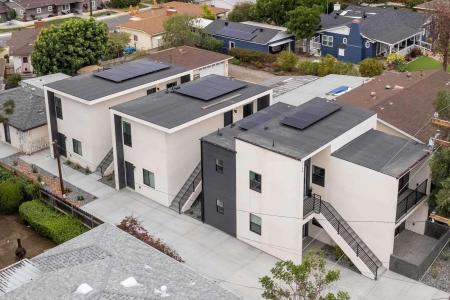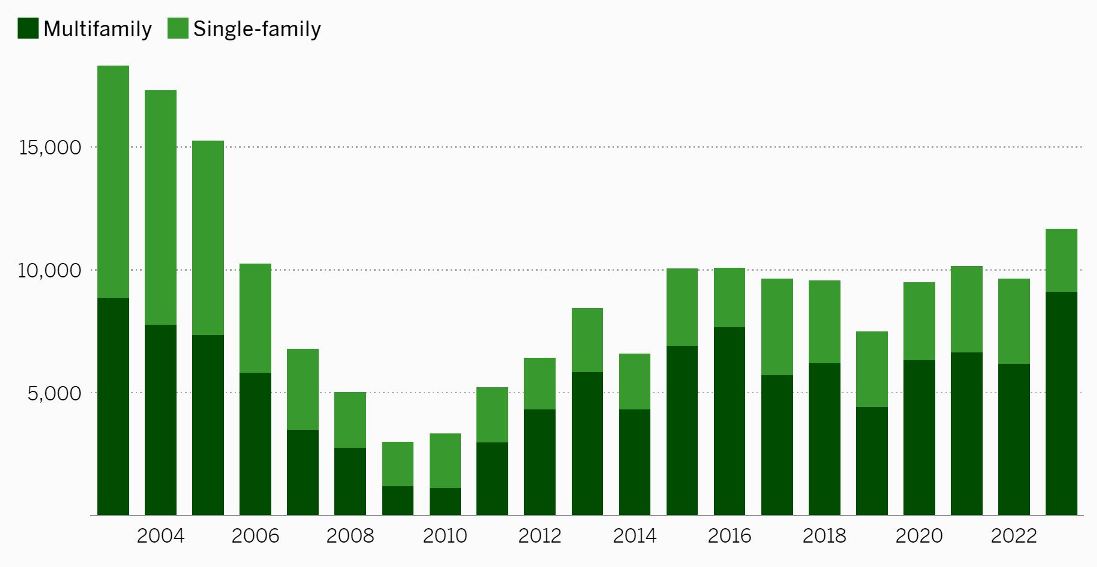
San Diego Built more Housing in 2023 than any of the Past 17 Years
Last year, 11,673 building permits were pulled across the county, a 21 percent increase from 2022, according to the Construction Industry Research Board. The majority of residential construction was in multifamily buildings, with 9,100 permits, including apartments, condos and townhouses. There were also 2,573 single-family permits, which includes accessory dwelling units.
This year took longer to figure out the numbers because the Sacramento-based research board decided to break out a separate category for ADUs. Typically, ADUs get lumped in with single-family homes in permit data.
The research board said 1,348 ADUs were built across San Diego County last year. That is more than the 1,225 single-family homes constructed.
The report doesn’t break down permits by community, but the city of San Diego previously said it issued 9,691 residential permits in 2023 — which would mean the rest of the county contributed around 17 percent to the housing stock.
Lori Holt Pfeiler, CEO of the local Building Industry Association, said the report was positive but it was important to keep in mind the region needs to catch up after years of underbuilding. The San Diego Association of Governments estimates around 20,000 new housing units are needed each year meet demand after decades of sluggish building.
“It’s a step in the right direction,” she said. “Eleven thousand is great but we need to do even better.”
Pfeiler said the city of San Diego is the leader in homebuilding with many programs to encourage residential construction, such as speeding up permits, making it easier to build on underutilized commercial sites and creating incentives for rent-restricted housing.
“The rest of the county needs to step up,” she said.
San Diego County has had the fastest rising home prices in the nation for six months for resale single-family homes, said the S&P Case-Shiller Indices. Meanwhile, rent prices — which are still the eighth-highest in the nation — were down annually last month by 3.7 percent, said Zumper, for a median monthly rent for a one-bedroom of $2,350.
It is the competition for a limited number of homes for sale, new or used, which housing analysts have attributed to San Diego’s rising prices — despite some of the highest mortgage rates in years.
San Diego County had been permitting around 9,000 to 10,000 homes a year, on average, since 2015. The last time the region crossed the 11,000 mark was back in 2005 when 15,258 residential building permits were issued.
Homebuilding fell off sharply during the Great Recession, hitting a low point in 2009 with 2,990 permits. Other slow years were 2010 with 3,342 permits and 2011 with 5,220 permits. San Diego, and much of the nation, have yet to reach building numbers seen before the recession.
SANDAG’s latest population estimates have the county growing from 3.2 million people now to 3.4 million in about 20 years. It then says the population will decrease to around 3.3 million by 2060. This estimate, from the start of this year, was down from previous estimates that had the population reaching 4 million.
Ray Major, chief economist at SANDAG, said the association’s estimates do not mean that the region should stop building housing. He estimates the county is short at least 100,000 units after years of underbuilding. Also, Major said one of the biggest reasons people are leaving the county in the first place is the cost of housing.
San Diego County is not alone in housing woes, with California ranked 49th, behind Utah, in the number of housing units per capita, said the McKinsey Global Institute. California typically produces about 80,000 new homes a year, said the California Department of Housing and Community Development, which it argues is 100,000 less than what is needed.
Source: SDuniontribune by Phillip Molnar






